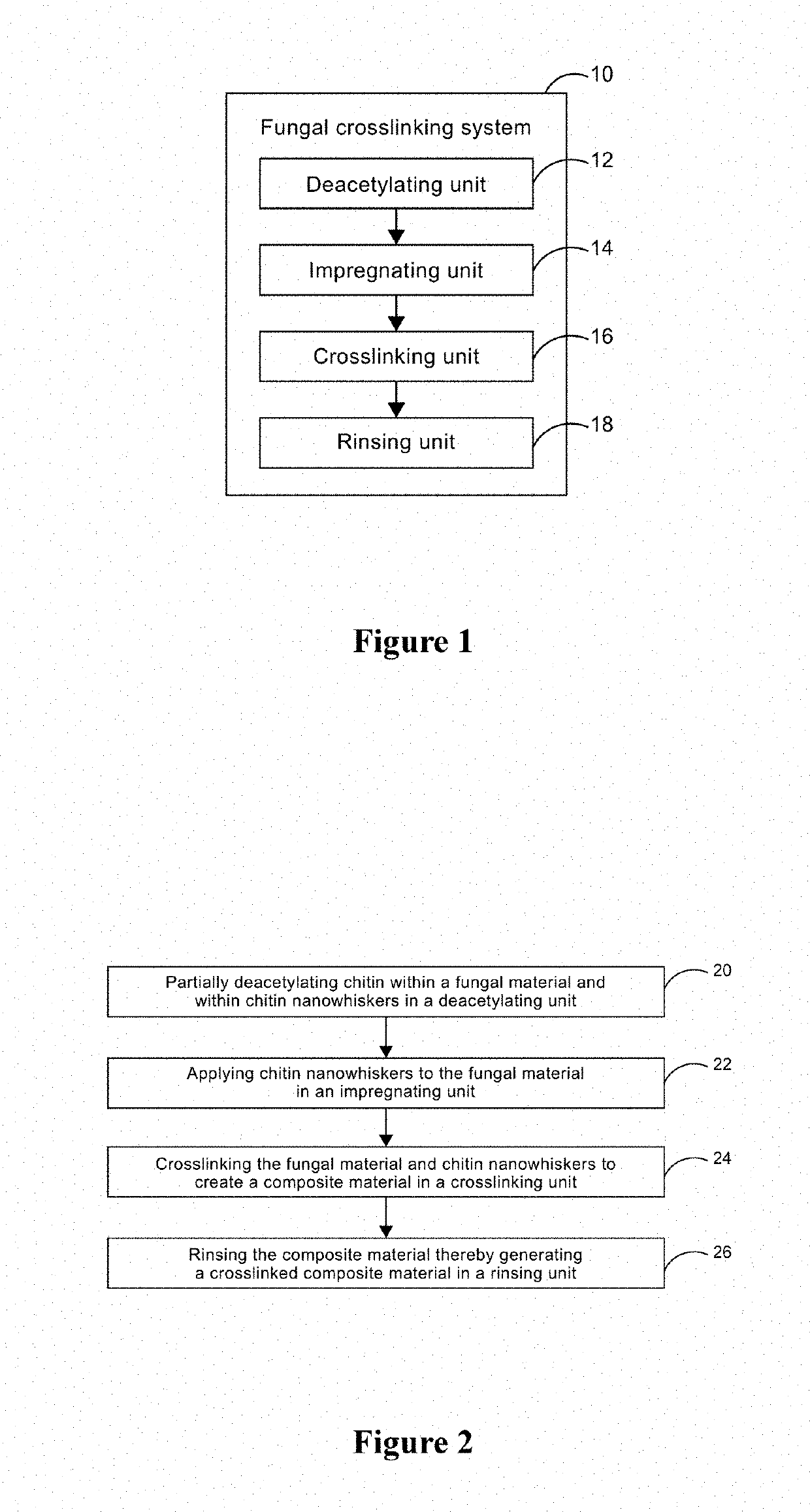Deacetylation and crosslinking of chitin and chitosan in fungal materials and their composites for tunable properties
- Summary
- Abstract
- Description
- Claims
- Application Information
AI Technical Summary
Benefits of technology
Problems solved by technology
Method used
Image
Examples
Example
[0037]In a second embodiment, the crosslinking unit 16 is designed to crosslink the fungal material and composite (such as cellulosic textiles) with themselves and each other using genipin material. In order to create a genipin first mixture, commercially available genipin powder is dissolved in acetic acid. The genipin first mixture is then mixed with a mixing solution to generate a genipin second mixture. The mixing solution has a pH rate ranging from 2 to 3. In said second embodiment of the invention, the genipin second mixture is applied to the fungal material at a genipin utilization rate to create a genipin fungal mixture which is incubated at an incubation condition with agitation to create a composite material. The genipin utilization rate ranges from 0.05%-4% w / w to the weight of the genipin polymer. Preferably, the incubation condition for incubating the genipin fungal mixture includes an incubation time of 40 minutes to several hours and an incubation temperature of 25 de...
Example
[0044]A third embodiment of the present invention comprises a crosslinked fungal composite material wherein the acetamide groups on the chitin chain are targeted for modification, as shown in FIG. 6. The acetamide groups on the chitin are utilized to create a bonding site for compounds that attach through an amide bond. Compounds that attached through an amide bond include glutaraldehyde, metal-complex tannins, and synthetic tannins (“syntans” or “syntan compounds”). In some embodiments, the acetamide groups are deacetylated into amine groups. Notably, deacetylated chitin is also referred to as chitosan.
Example
[0045]A fourth embodiment of the present invention comprises a crosslinked fungal composite wherein the links are created by phenolic compounds such as vegetable tannins, among polysaccharides (sugar molecules) which exist on the hyphal cells. Such a crosslinked fungal material would exhibit links between bonding sites on the hydroxyl groups of the polysaccharides. Such hydroxyl groups of the polysaccharides are highlighted by a dashed circle in FIG. 7. These polysaccharide bonding sites may also be on the cellulosic material that is used as the composite along with the fungal material, such as a cotton textile layer. As described above, links may also be created by the partial degradation of chitin molecules into chitosan followed by a reaction with genipin.
[0046]Another embodiment of the present invention utilizes bonding sites on the carbonaceous backbone of the chitin molecule itself. Binding to the carbonaceous backbone may be achieved by various methods known to persons skille...
PUM
| Property | Measurement | Unit |
|---|---|---|
| Angle | aaaaa | aaaaa |
| Time | aaaaa | aaaaa |
| Temperature | aaaaa | aaaaa |
Abstract
Description
Claims
Application Information
 Login to View More
Login to View More - R&D Engineer
- R&D Manager
- IP Professional
- Industry Leading Data Capabilities
- Powerful AI technology
- Patent DNA Extraction
Browse by: Latest US Patents, China's latest patents, Technical Efficacy Thesaurus, Application Domain, Technology Topic, Popular Technical Reports.
© 2024 PatSnap. All rights reserved.Legal|Privacy policy|Modern Slavery Act Transparency Statement|Sitemap|About US| Contact US: help@patsnap.com










